MSc Consultancy Report: Animal Welfare Challenges and Strategies
VerifiedAdded on 2022/08/21
|14
|3901
|13
Report
AI Summary
This consultancy report examines the operational challenges faced by Animal Welfare, a non-profit organization focused on animal rescue and rehabilitation. The report identifies key issues including low funding, employee burnout, high turnover rates, and work-life balance concerns. It provides an in-depth analysis of these problems, supported by a review of relevant literature on occupational health, mental wellbeing, and financial constraints in non-profit organizations. The report proposes specific interventions and recommendations to improve the situation, such as addressing financial challenges, improving employee support systems, and implementing strategies to reduce work-related stress and enhance employee retention. The report concludes with suggestions for further interventions to enhance Animal Care's overall performance and employee wellbeing.
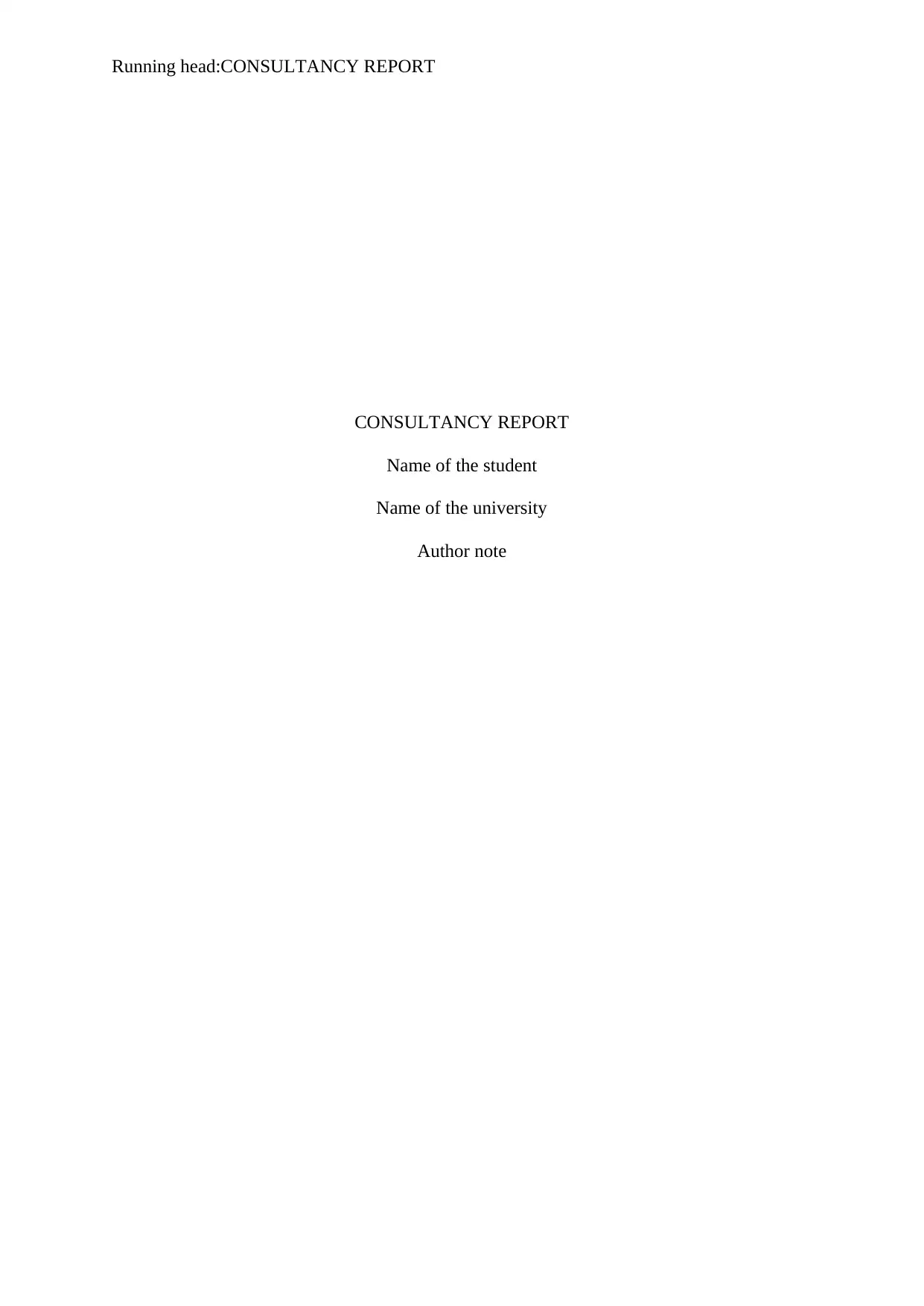
Running head:CONSULTANCY REPORT
CONSULTANCY REPORT
Name of the student
Name of the university
Author note
CONSULTANCY REPORT
Name of the student
Name of the university
Author note
Paraphrase This Document
Need a fresh take? Get an instant paraphrase of this document with our AI Paraphraser
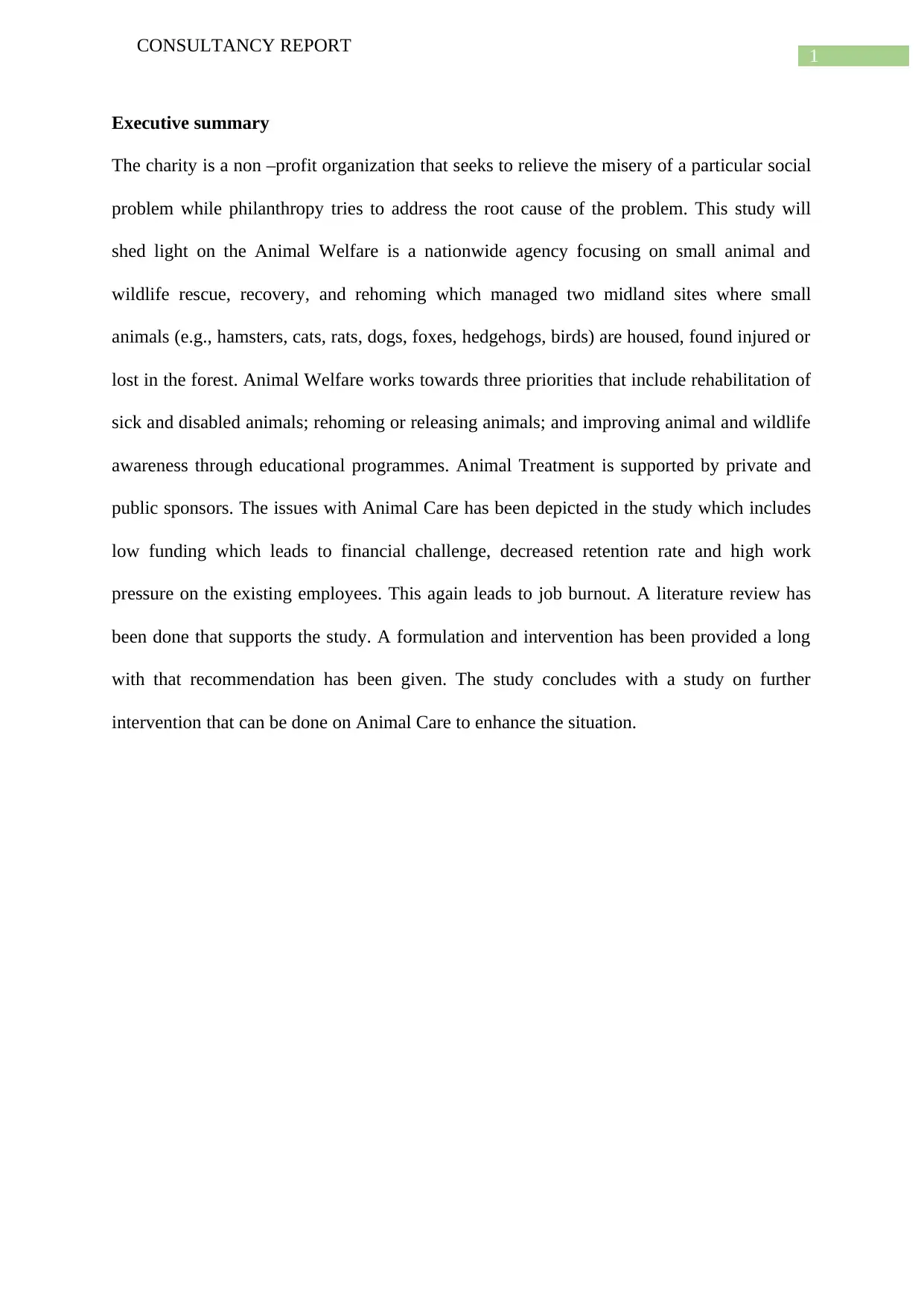
1
CONSULTANCY REPORT
Executive summary
The charity is a non –profit organization that seeks to relieve the misery of a particular social
problem while philanthropy tries to address the root cause of the problem. This study will
shed light on the Animal Welfare is a nationwide agency focusing on small animal and
wildlife rescue, recovery, and rehoming which managed two midland sites where small
animals (e.g., hamsters, cats, rats, dogs, foxes, hedgehogs, birds) are housed, found injured or
lost in the forest. Animal Welfare works towards three priorities that include rehabilitation of
sick and disabled animals; rehoming or releasing animals; and improving animal and wildlife
awareness through educational programmes. Animal Treatment is supported by private and
public sponsors. The issues with Animal Care has been depicted in the study which includes
low funding which leads to financial challenge, decreased retention rate and high work
pressure on the existing employees. This again leads to job burnout. A literature review has
been done that supports the study. A formulation and intervention has been provided a long
with that recommendation has been given. The study concludes with a study on further
intervention that can be done on Animal Care to enhance the situation.
CONSULTANCY REPORT
Executive summary
The charity is a non –profit organization that seeks to relieve the misery of a particular social
problem while philanthropy tries to address the root cause of the problem. This study will
shed light on the Animal Welfare is a nationwide agency focusing on small animal and
wildlife rescue, recovery, and rehoming which managed two midland sites where small
animals (e.g., hamsters, cats, rats, dogs, foxes, hedgehogs, birds) are housed, found injured or
lost in the forest. Animal Welfare works towards three priorities that include rehabilitation of
sick and disabled animals; rehoming or releasing animals; and improving animal and wildlife
awareness through educational programmes. Animal Treatment is supported by private and
public sponsors. The issues with Animal Care has been depicted in the study which includes
low funding which leads to financial challenge, decreased retention rate and high work
pressure on the existing employees. This again leads to job burnout. A literature review has
been done that supports the study. A formulation and intervention has been provided a long
with that recommendation has been given. The study concludes with a study on further
intervention that can be done on Animal Care to enhance the situation.
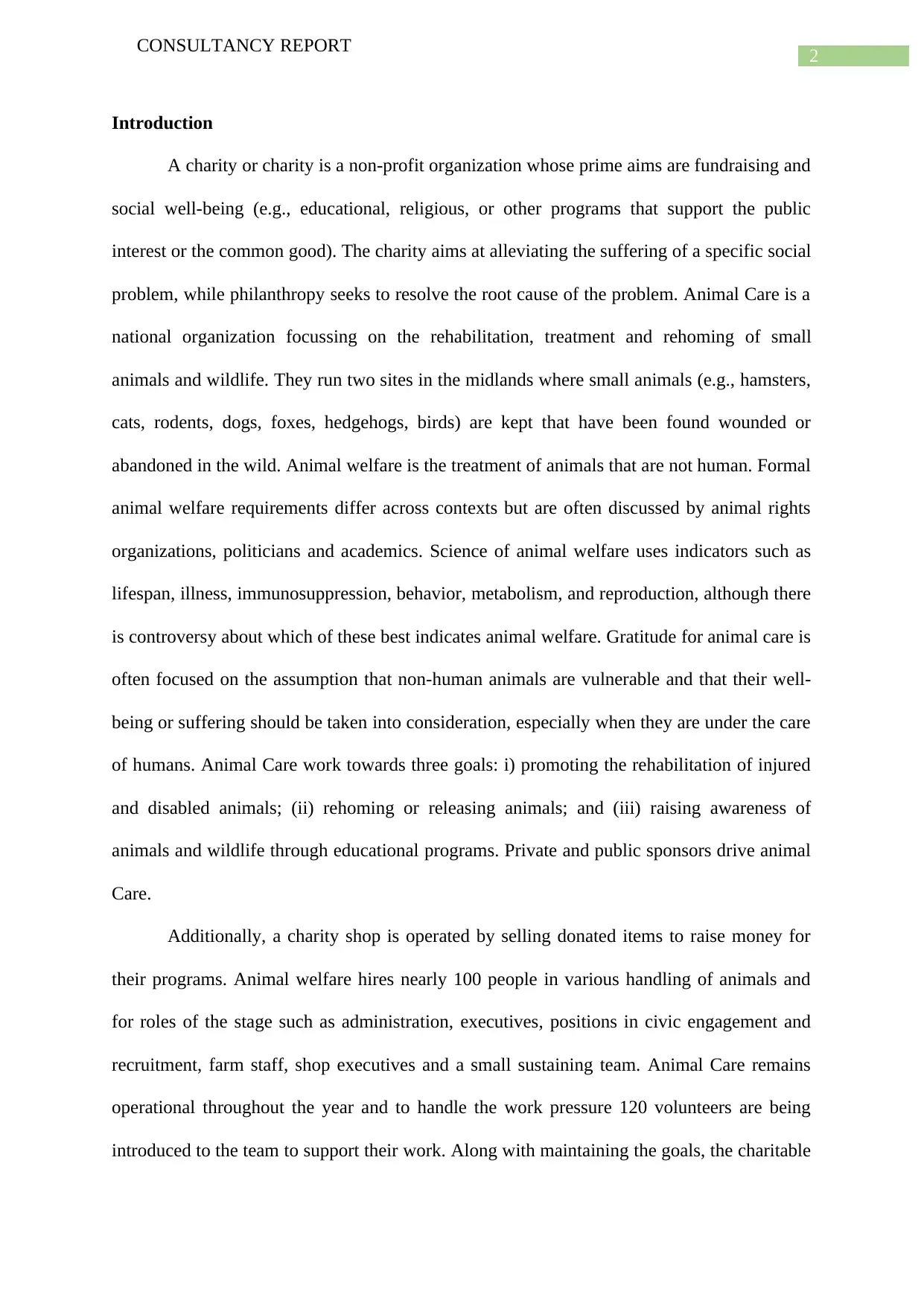
2
CONSULTANCY REPORT
Introduction
A charity or charity is a non-profit organization whose prime aims are fundraising and
social well-being (e.g., educational, religious, or other programs that support the public
interest or the common good). The charity aims at alleviating the suffering of a specific social
problem, while philanthropy seeks to resolve the root cause of the problem. Animal Care is a
national organization focussing on the rehabilitation, treatment and rehoming of small
animals and wildlife. They run two sites in the midlands where small animals (e.g., hamsters,
cats, rodents, dogs, foxes, hedgehogs, birds) are kept that have been found wounded or
abandoned in the wild. Animal welfare is the treatment of animals that are not human. Formal
animal welfare requirements differ across contexts but are often discussed by animal rights
organizations, politicians and academics. Science of animal welfare uses indicators such as
lifespan, illness, immunosuppression, behavior, metabolism, and reproduction, although there
is controversy about which of these best indicates animal welfare. Gratitude for animal care is
often focused on the assumption that non-human animals are vulnerable and that their well-
being or suffering should be taken into consideration, especially when they are under the care
of humans. Animal Care work towards three goals: i) promoting the rehabilitation of injured
and disabled animals; (ii) rehoming or releasing animals; and (iii) raising awareness of
animals and wildlife through educational programs. Private and public sponsors drive animal
Care.
Additionally, a charity shop is operated by selling donated items to raise money for
their programs. Animal welfare hires nearly 100 people in various handling of animals and
for roles of the stage such as administration, executives, positions in civic engagement and
recruitment, farm staff, shop executives and a small sustaining team. Animal Care remains
operational throughout the year and to handle the work pressure 120 volunteers are being
introduced to the team to support their work. Along with maintaining the goals, the charitable
CONSULTANCY REPORT
Introduction
A charity or charity is a non-profit organization whose prime aims are fundraising and
social well-being (e.g., educational, religious, or other programs that support the public
interest or the common good). The charity aims at alleviating the suffering of a specific social
problem, while philanthropy seeks to resolve the root cause of the problem. Animal Care is a
national organization focussing on the rehabilitation, treatment and rehoming of small
animals and wildlife. They run two sites in the midlands where small animals (e.g., hamsters,
cats, rodents, dogs, foxes, hedgehogs, birds) are kept that have been found wounded or
abandoned in the wild. Animal welfare is the treatment of animals that are not human. Formal
animal welfare requirements differ across contexts but are often discussed by animal rights
organizations, politicians and academics. Science of animal welfare uses indicators such as
lifespan, illness, immunosuppression, behavior, metabolism, and reproduction, although there
is controversy about which of these best indicates animal welfare. Gratitude for animal care is
often focused on the assumption that non-human animals are vulnerable and that their well-
being or suffering should be taken into consideration, especially when they are under the care
of humans. Animal Care work towards three goals: i) promoting the rehabilitation of injured
and disabled animals; (ii) rehoming or releasing animals; and (iii) raising awareness of
animals and wildlife through educational programs. Private and public sponsors drive animal
Care.
Additionally, a charity shop is operated by selling donated items to raise money for
their programs. Animal welfare hires nearly 100 people in various handling of animals and
for roles of the stage such as administration, executives, positions in civic engagement and
recruitment, farm staff, shop executives and a small sustaining team. Animal Care remains
operational throughout the year and to handle the work pressure 120 volunteers are being
introduced to the team to support their work. Along with maintaining the goals, the charitable
⊘ This is a preview!⊘
Do you want full access?
Subscribe today to unlock all pages.

Trusted by 1+ million students worldwide
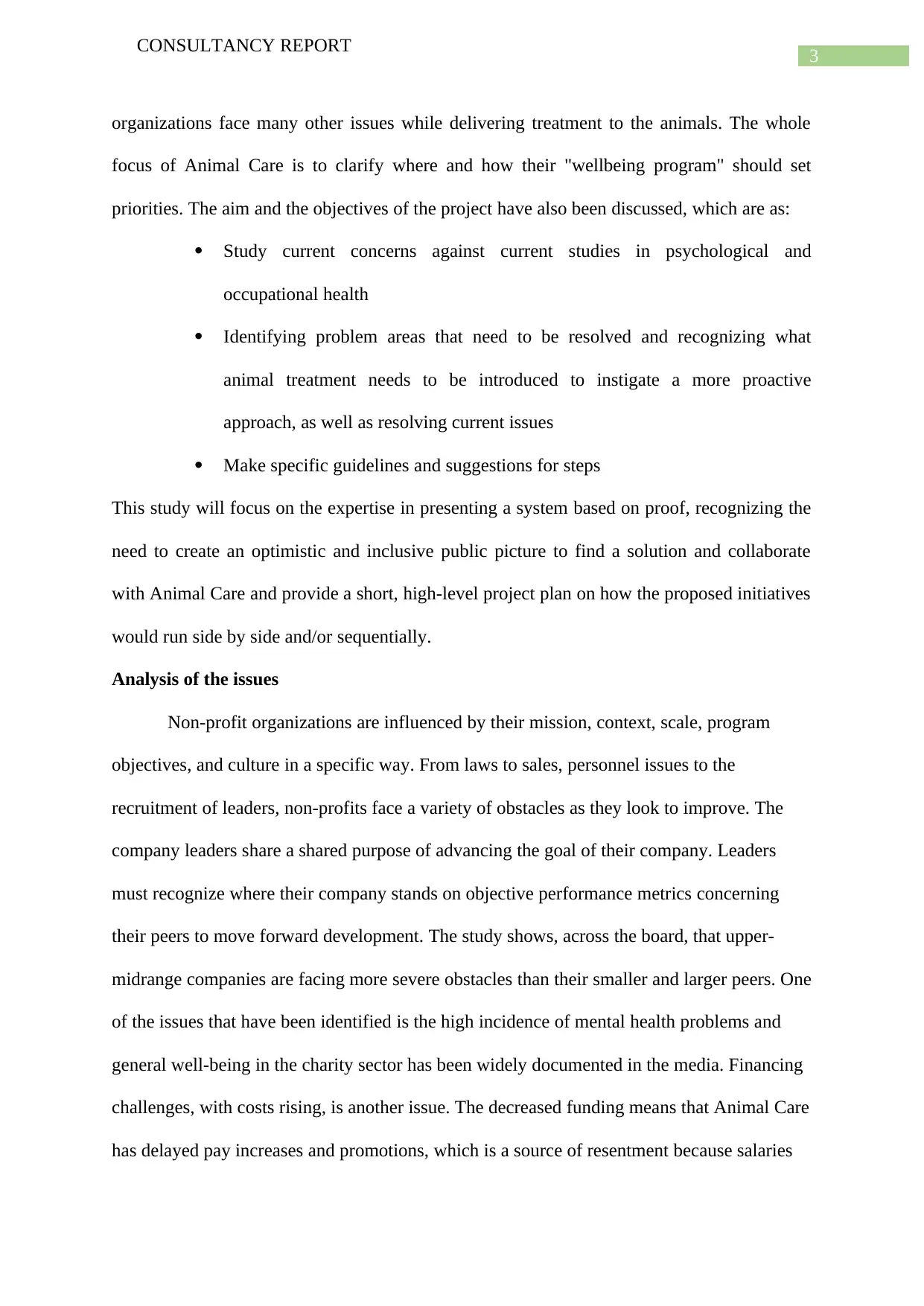
3
CONSULTANCY REPORT
organizations face many other issues while delivering treatment to the animals. The whole
focus of Animal Care is to clarify where and how their "wellbeing program" should set
priorities. The aim and the objectives of the project have also been discussed, which are as:
Study current concerns against current studies in psychological and
occupational health
Identifying problem areas that need to be resolved and recognizing what
animal treatment needs to be introduced to instigate a more proactive
approach, as well as resolving current issues
Make specific guidelines and suggestions for steps
This study will focus on the expertise in presenting a system based on proof, recognizing the
need to create an optimistic and inclusive public picture to find a solution and collaborate
with Animal Care and provide a short, high-level project plan on how the proposed initiatives
would run side by side and/or sequentially.
Analysis of the issues
Non-profit organizations are influenced by their mission, context, scale, program
objectives, and culture in a specific way. From laws to sales, personnel issues to the
recruitment of leaders, non-profits face a variety of obstacles as they look to improve. The
company leaders share a shared purpose of advancing the goal of their company. Leaders
must recognize where their company stands on objective performance metrics concerning
their peers to move forward development. The study shows, across the board, that upper-
midrange companies are facing more severe obstacles than their smaller and larger peers. One
of the issues that have been identified is the high incidence of mental health problems and
general well-being in the charity sector has been widely documented in the media. Financing
challenges, with costs rising, is another issue. The decreased funding means that Animal Care
has delayed pay increases and promotions, which is a source of resentment because salaries
CONSULTANCY REPORT
organizations face many other issues while delivering treatment to the animals. The whole
focus of Animal Care is to clarify where and how their "wellbeing program" should set
priorities. The aim and the objectives of the project have also been discussed, which are as:
Study current concerns against current studies in psychological and
occupational health
Identifying problem areas that need to be resolved and recognizing what
animal treatment needs to be introduced to instigate a more proactive
approach, as well as resolving current issues
Make specific guidelines and suggestions for steps
This study will focus on the expertise in presenting a system based on proof, recognizing the
need to create an optimistic and inclusive public picture to find a solution and collaborate
with Animal Care and provide a short, high-level project plan on how the proposed initiatives
would run side by side and/or sequentially.
Analysis of the issues
Non-profit organizations are influenced by their mission, context, scale, program
objectives, and culture in a specific way. From laws to sales, personnel issues to the
recruitment of leaders, non-profits face a variety of obstacles as they look to improve. The
company leaders share a shared purpose of advancing the goal of their company. Leaders
must recognize where their company stands on objective performance metrics concerning
their peers to move forward development. The study shows, across the board, that upper-
midrange companies are facing more severe obstacles than their smaller and larger peers. One
of the issues that have been identified is the high incidence of mental health problems and
general well-being in the charity sector has been widely documented in the media. Financing
challenges, with costs rising, is another issue. The decreased funding means that Animal Care
has delayed pay increases and promotions, which is a source of resentment because salaries
Paraphrase This Document
Need a fresh take? Get an instant paraphrase of this document with our AI Paraphraser
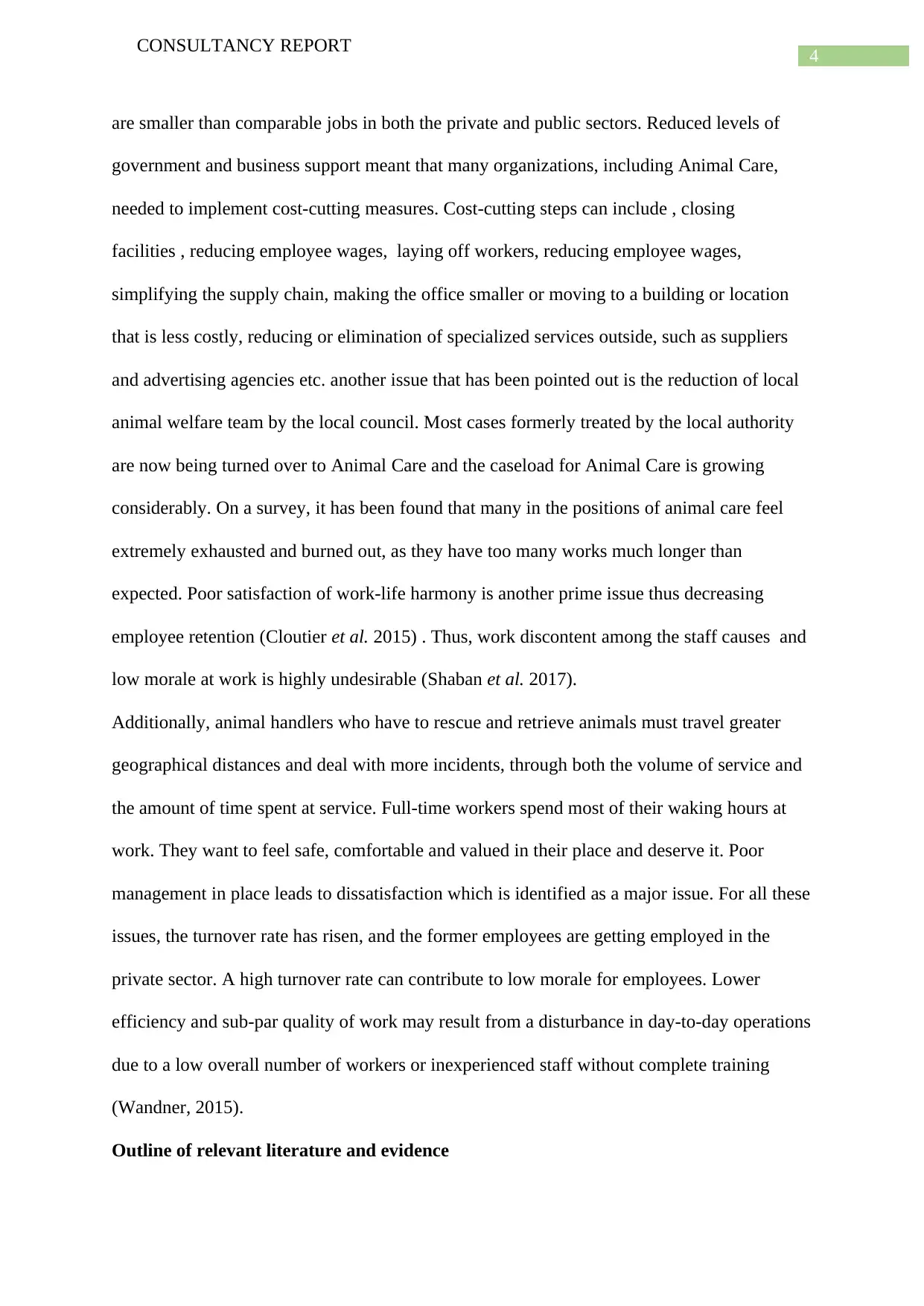
4
CONSULTANCY REPORT
are smaller than comparable jobs in both the private and public sectors. Reduced levels of
government and business support meant that many organizations, including Animal Care,
needed to implement cost-cutting measures. Cost-cutting steps can include , closing
facilities , reducing employee wages, laying off workers, reducing employee wages,
simplifying the supply chain, making the office smaller or moving to a building or location
that is less costly, reducing or elimination of specialized services outside, such as suppliers
and advertising agencies etc. another issue that has been pointed out is the reduction of local
animal welfare team by the local council. Most cases formerly treated by the local authority
are now being turned over to Animal Care and the caseload for Animal Care is growing
considerably. On a survey, it has been found that many in the positions of animal care feel
extremely exhausted and burned out, as they have too many works much longer than
expected. Poor satisfaction of work-life harmony is another prime issue thus decreasing
employee retention (Cloutier et al. 2015) . Thus, work discontent among the staff causes and
low morale at work is highly undesirable (Shaban et al. 2017).
Additionally, animal handlers who have to rescue and retrieve animals must travel greater
geographical distances and deal with more incidents, through both the volume of service and
the amount of time spent at service. Full-time workers spend most of their waking hours at
work. They want to feel safe, comfortable and valued in their place and deserve it. Poor
management in place leads to dissatisfaction which is identified as a major issue. For all these
issues, the turnover rate has risen, and the former employees are getting employed in the
private sector. A high turnover rate can contribute to low morale for employees. Lower
efficiency and sub-par quality of work may result from a disturbance in day-to-day operations
due to a low overall number of workers or inexperienced staff without complete training
(Wandner, 2015).
Outline of relevant literature and evidence
CONSULTANCY REPORT
are smaller than comparable jobs in both the private and public sectors. Reduced levels of
government and business support meant that many organizations, including Animal Care,
needed to implement cost-cutting measures. Cost-cutting steps can include , closing
facilities , reducing employee wages, laying off workers, reducing employee wages,
simplifying the supply chain, making the office smaller or moving to a building or location
that is less costly, reducing or elimination of specialized services outside, such as suppliers
and advertising agencies etc. another issue that has been pointed out is the reduction of local
animal welfare team by the local council. Most cases formerly treated by the local authority
are now being turned over to Animal Care and the caseload for Animal Care is growing
considerably. On a survey, it has been found that many in the positions of animal care feel
extremely exhausted and burned out, as they have too many works much longer than
expected. Poor satisfaction of work-life harmony is another prime issue thus decreasing
employee retention (Cloutier et al. 2015) . Thus, work discontent among the staff causes and
low morale at work is highly undesirable (Shaban et al. 2017).
Additionally, animal handlers who have to rescue and retrieve animals must travel greater
geographical distances and deal with more incidents, through both the volume of service and
the amount of time spent at service. Full-time workers spend most of their waking hours at
work. They want to feel safe, comfortable and valued in their place and deserve it. Poor
management in place leads to dissatisfaction which is identified as a major issue. For all these
issues, the turnover rate has risen, and the former employees are getting employed in the
private sector. A high turnover rate can contribute to low morale for employees. Lower
efficiency and sub-par quality of work may result from a disturbance in day-to-day operations
due to a low overall number of workers or inexperienced staff without complete training
(Wandner, 2015).
Outline of relevant literature and evidence
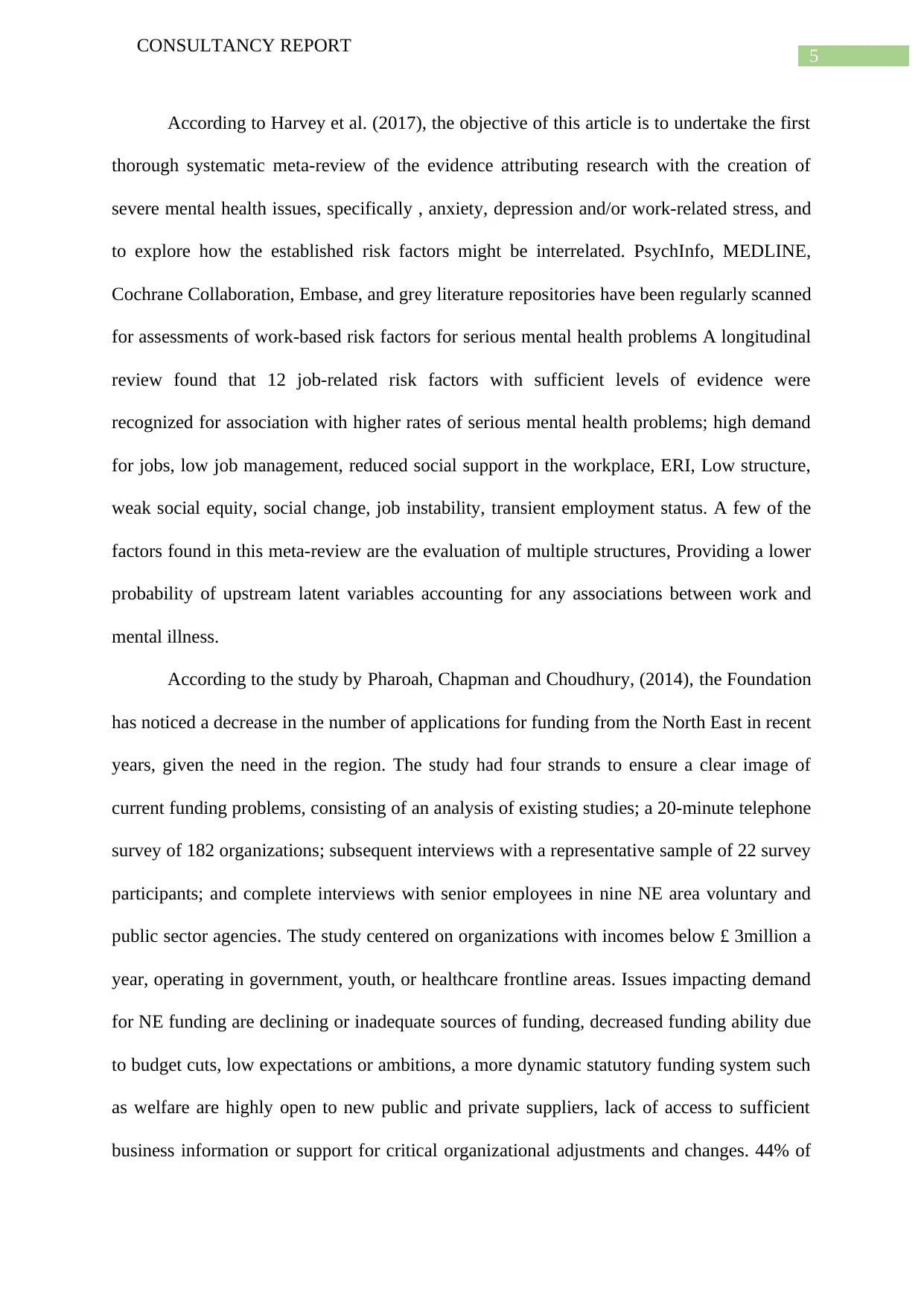
5
CONSULTANCY REPORT
According to Harvey et al. (2017), the objective of this article is to undertake the first
thorough systematic meta-review of the evidence attributing research with the creation of
severe mental health issues, specifically , anxiety, depression and/or work-related stress, and
to explore how the established risk factors might be interrelated. PsychInfo, MEDLINE,
Cochrane Collaboration, Embase, and grey literature repositories have been regularly scanned
for assessments of work-based risk factors for serious mental health problems A longitudinal
review found that 12 job-related risk factors with sufficient levels of evidence were
recognized for association with higher rates of serious mental health problems; high demand
for jobs, low job management, reduced social support in the workplace, ERI, Low structure,
weak social equity, social change, job instability, transient employment status. A few of the
factors found in this meta-review are the evaluation of multiple structures, Providing a lower
probability of upstream latent variables accounting for any associations between work and
mental illness.
According to the study by Pharoah, Chapman and Choudhury, (2014), the Foundation
has noticed a decrease in the number of applications for funding from the North East in recent
years, given the need in the region. The study had four strands to ensure a clear image of
current funding problems, consisting of an analysis of existing studies; a 20-minute telephone
survey of 182 organizations; subsequent interviews with a representative sample of 22 survey
participants; and complete interviews with senior employees in nine NE area voluntary and
public sector agencies. The study centered on organizations with incomes below £ 3million a
year, operating in government, youth, or healthcare frontline areas. Issues impacting demand
for NE funding are declining or inadequate sources of funding, decreased funding ability due
to budget cuts, low expectations or ambitions, a more dynamic statutory funding system such
as welfare are highly open to new public and private suppliers, lack of access to sufficient
business information or support for critical organizational adjustments and changes. 44% of
CONSULTANCY REPORT
According to Harvey et al. (2017), the objective of this article is to undertake the first
thorough systematic meta-review of the evidence attributing research with the creation of
severe mental health issues, specifically , anxiety, depression and/or work-related stress, and
to explore how the established risk factors might be interrelated. PsychInfo, MEDLINE,
Cochrane Collaboration, Embase, and grey literature repositories have been regularly scanned
for assessments of work-based risk factors for serious mental health problems A longitudinal
review found that 12 job-related risk factors with sufficient levels of evidence were
recognized for association with higher rates of serious mental health problems; high demand
for jobs, low job management, reduced social support in the workplace, ERI, Low structure,
weak social equity, social change, job instability, transient employment status. A few of the
factors found in this meta-review are the evaluation of multiple structures, Providing a lower
probability of upstream latent variables accounting for any associations between work and
mental illness.
According to the study by Pharoah, Chapman and Choudhury, (2014), the Foundation
has noticed a decrease in the number of applications for funding from the North East in recent
years, given the need in the region. The study had four strands to ensure a clear image of
current funding problems, consisting of an analysis of existing studies; a 20-minute telephone
survey of 182 organizations; subsequent interviews with a representative sample of 22 survey
participants; and complete interviews with senior employees in nine NE area voluntary and
public sector agencies. The study centered on organizations with incomes below £ 3million a
year, operating in government, youth, or healthcare frontline areas. Issues impacting demand
for NE funding are declining or inadequate sources of funding, decreased funding ability due
to budget cuts, low expectations or ambitions, a more dynamic statutory funding system such
as welfare are highly open to new public and private suppliers, lack of access to sufficient
business information or support for critical organizational adjustments and changes. 44% of
⊘ This is a preview!⊘
Do you want full access?
Subscribe today to unlock all pages.

Trusted by 1+ million students worldwide
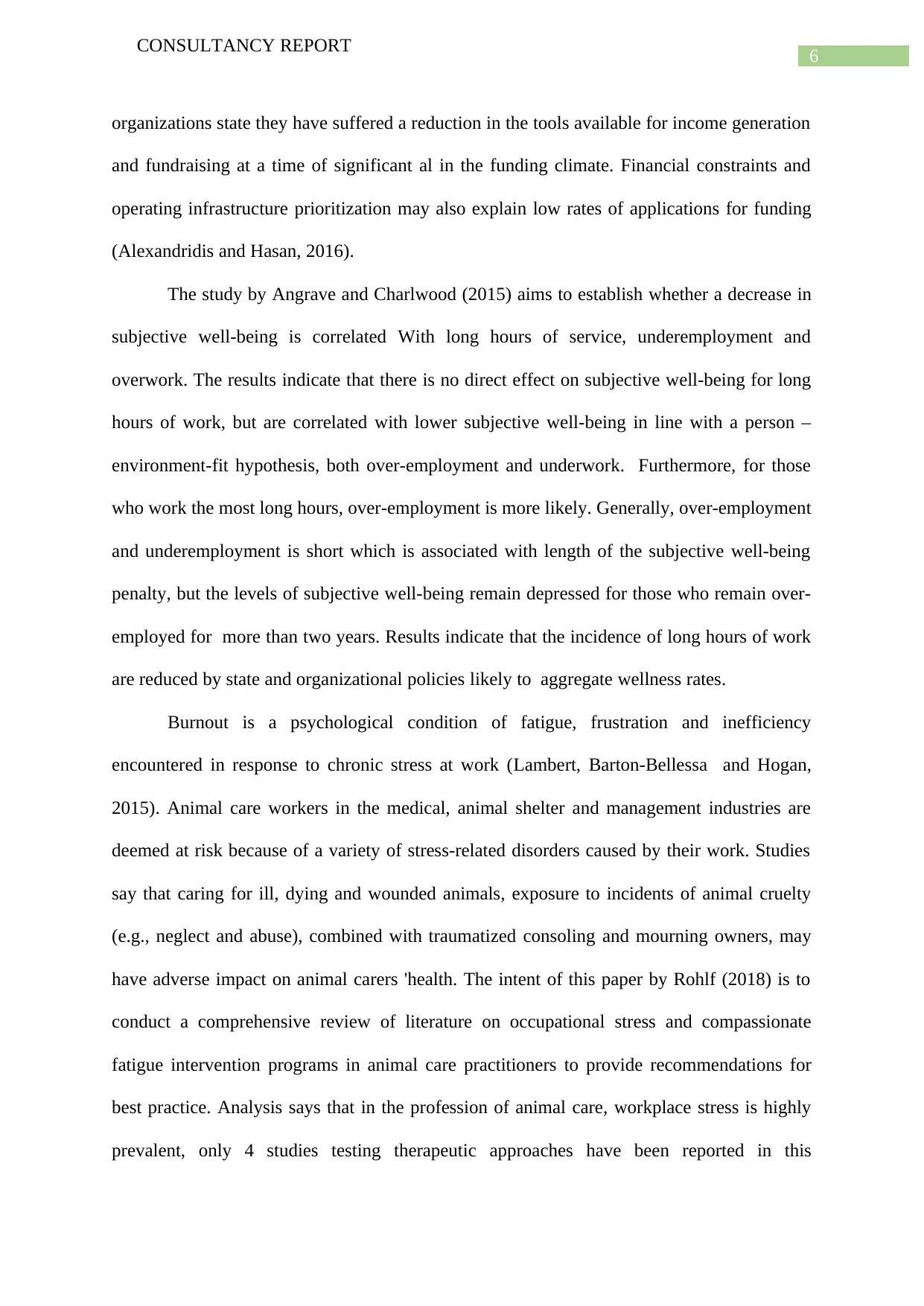
6
CONSULTANCY REPORT
organizations state they have suffered a reduction in the tools available for income generation
and fundraising at a time of significant al in the funding climate. Financial constraints and
operating infrastructure prioritization may also explain low rates of applications for funding
(Alexandridis and Hasan, 2016).
The study by Angrave and Charlwood (2015) aims to establish whether a decrease in
subjective well-being is correlated With long hours of service, underemployment and
overwork. The results indicate that there is no direct effect on subjective well-being for long
hours of work, but are correlated with lower subjective well-being in line with a person –
environment-fit hypothesis, both over-employment and underwork. Furthermore, for those
who work the most long hours, over-employment is more likely. Generally, over-employment
and underemployment is short which is associated with length of the subjective well-being
penalty, but the levels of subjective well-being remain depressed for those who remain over-
employed for more than two years. Results indicate that the incidence of long hours of work
are reduced by state and organizational policies likely to aggregate wellness rates.
Burnout is a psychological condition of fatigue, frustration and inefficiency
encountered in response to chronic stress at work (Lambert, Barton-Bellessa and Hogan,
2015). Animal care workers in the medical, animal shelter and management industries are
deemed at risk because of a variety of stress-related disorders caused by their work. Studies
say that caring for ill, dying and wounded animals, exposure to incidents of animal cruelty
(e.g., neglect and abuse), combined with traumatized consoling and mourning owners, may
have adverse impact on animal carers 'health. The intent of this paper by Rohlf (2018) is to
conduct a comprehensive review of literature on occupational stress and compassionate
fatigue intervention programs in animal care practitioners to provide recommendations for
best practice. Analysis says that in the profession of animal care, workplace stress is highly
prevalent, only 4 studies testing therapeutic approaches have been reported in this
CONSULTANCY REPORT
organizations state they have suffered a reduction in the tools available for income generation
and fundraising at a time of significant al in the funding climate. Financial constraints and
operating infrastructure prioritization may also explain low rates of applications for funding
(Alexandridis and Hasan, 2016).
The study by Angrave and Charlwood (2015) aims to establish whether a decrease in
subjective well-being is correlated With long hours of service, underemployment and
overwork. The results indicate that there is no direct effect on subjective well-being for long
hours of work, but are correlated with lower subjective well-being in line with a person –
environment-fit hypothesis, both over-employment and underwork. Furthermore, for those
who work the most long hours, over-employment is more likely. Generally, over-employment
and underemployment is short which is associated with length of the subjective well-being
penalty, but the levels of subjective well-being remain depressed for those who remain over-
employed for more than two years. Results indicate that the incidence of long hours of work
are reduced by state and organizational policies likely to aggregate wellness rates.
Burnout is a psychological condition of fatigue, frustration and inefficiency
encountered in response to chronic stress at work (Lambert, Barton-Bellessa and Hogan,
2015). Animal care workers in the medical, animal shelter and management industries are
deemed at risk because of a variety of stress-related disorders caused by their work. Studies
say that caring for ill, dying and wounded animals, exposure to incidents of animal cruelty
(e.g., neglect and abuse), combined with traumatized consoling and mourning owners, may
have adverse impact on animal carers 'health. The intent of this paper by Rohlf (2018) is to
conduct a comprehensive review of literature on occupational stress and compassionate
fatigue intervention programs in animal care practitioners to provide recommendations for
best practice. Analysis says that in the profession of animal care, workplace stress is highly
prevalent, only 4 studies testing therapeutic approaches have been reported in this
Paraphrase This Document
Need a fresh take? Get an instant paraphrase of this document with our AI Paraphraser
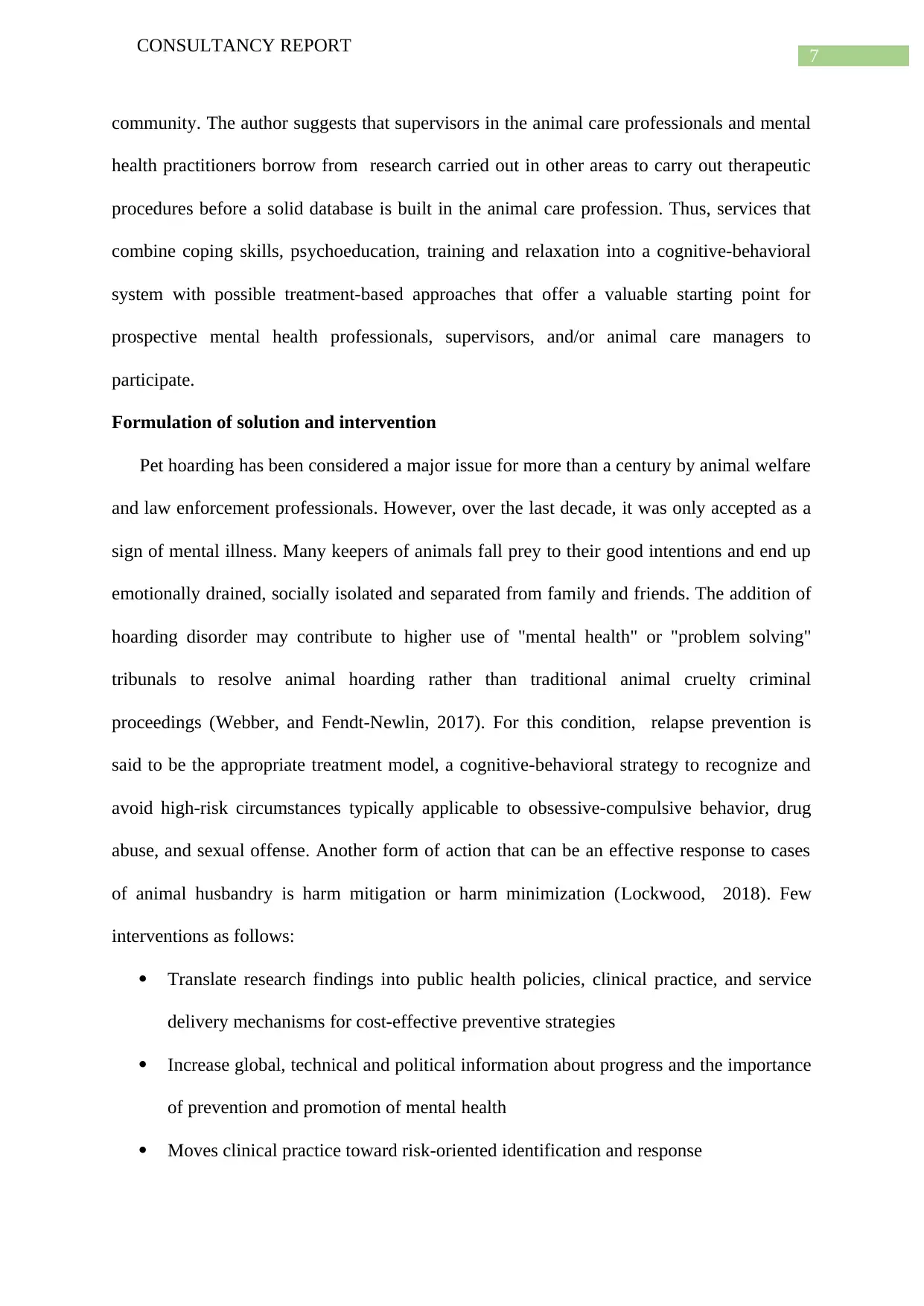
7
CONSULTANCY REPORT
community. The author suggests that supervisors in the animal care professionals and mental
health practitioners borrow from research carried out in other areas to carry out therapeutic
procedures before a solid database is built in the animal care profession. Thus, services that
combine coping skills, psychoeducation, training and relaxation into a cognitive-behavioral
system with possible treatment-based approaches that offer a valuable starting point for
prospective mental health professionals, supervisors, and/or animal care managers to
participate.
Formulation of solution and intervention
Pet hoarding has been considered a major issue for more than a century by animal welfare
and law enforcement professionals. However, over the last decade, it was only accepted as a
sign of mental illness. Many keepers of animals fall prey to their good intentions and end up
emotionally drained, socially isolated and separated from family and friends. The addition of
hoarding disorder may contribute to higher use of "mental health" or "problem solving"
tribunals to resolve animal hoarding rather than traditional animal cruelty criminal
proceedings (Webber, and Fendt-Newlin, 2017). For this condition, relapse prevention is
said to be the appropriate treatment model, a cognitive-behavioral strategy to recognize and
avoid high-risk circumstances typically applicable to obsessive-compulsive behavior, drug
abuse, and sexual offense. Another form of action that can be an effective response to cases
of animal husbandry is harm mitigation or harm minimization (Lockwood, 2018). Few
interventions as follows:
Translate research findings into public health policies, clinical practice, and service
delivery mechanisms for cost-effective preventive strategies
Increase global, technical and political information about progress and the importance
of prevention and promotion of mental health
Moves clinical practice toward risk-oriented identification and response
CONSULTANCY REPORT
community. The author suggests that supervisors in the animal care professionals and mental
health practitioners borrow from research carried out in other areas to carry out therapeutic
procedures before a solid database is built in the animal care profession. Thus, services that
combine coping skills, psychoeducation, training and relaxation into a cognitive-behavioral
system with possible treatment-based approaches that offer a valuable starting point for
prospective mental health professionals, supervisors, and/or animal care managers to
participate.
Formulation of solution and intervention
Pet hoarding has been considered a major issue for more than a century by animal welfare
and law enforcement professionals. However, over the last decade, it was only accepted as a
sign of mental illness. Many keepers of animals fall prey to their good intentions and end up
emotionally drained, socially isolated and separated from family and friends. The addition of
hoarding disorder may contribute to higher use of "mental health" or "problem solving"
tribunals to resolve animal hoarding rather than traditional animal cruelty criminal
proceedings (Webber, and Fendt-Newlin, 2017). For this condition, relapse prevention is
said to be the appropriate treatment model, a cognitive-behavioral strategy to recognize and
avoid high-risk circumstances typically applicable to obsessive-compulsive behavior, drug
abuse, and sexual offense. Another form of action that can be an effective response to cases
of animal husbandry is harm mitigation or harm minimization (Lockwood, 2018). Few
interventions as follows:
Translate research findings into public health policies, clinical practice, and service
delivery mechanisms for cost-effective preventive strategies
Increase global, technical and political information about progress and the importance
of prevention and promotion of mental health
Moves clinical practice toward risk-oriented identification and response
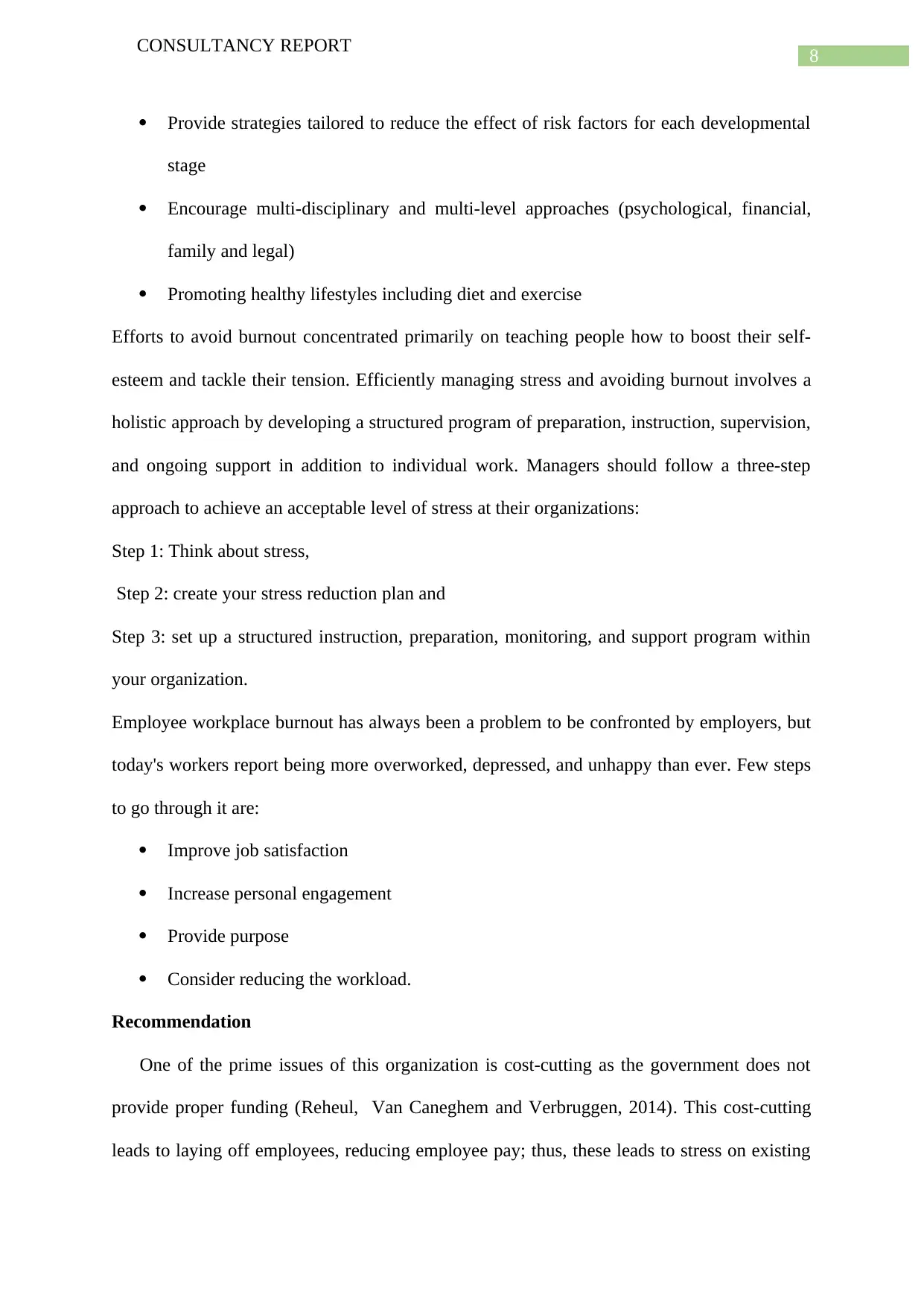
8
CONSULTANCY REPORT
Provide strategies tailored to reduce the effect of risk factors for each developmental
stage
Encourage multi-disciplinary and multi-level approaches (psychological, financial,
family and legal)
Promoting healthy lifestyles including diet and exercise
Efforts to avoid burnout concentrated primarily on teaching people how to boost their self-
esteem and tackle their tension. Efficiently managing stress and avoiding burnout involves a
holistic approach by developing a structured program of preparation, instruction, supervision,
and ongoing support in addition to individual work. Managers should follow a three-step
approach to achieve an acceptable level of stress at their organizations:
Step 1: Think about stress,
Step 2: create your stress reduction plan and
Step 3: set up a structured instruction, preparation, monitoring, and support program within
your organization.
Employee workplace burnout has always been a problem to be confronted by employers, but
today's workers report being more overworked, depressed, and unhappy than ever. Few steps
to go through it are:
Improve job satisfaction
Increase personal engagement
Provide purpose
Consider reducing the workload.
Recommendation
One of the prime issues of this organization is cost-cutting as the government does not
provide proper funding (Reheul, Van Caneghem and Verbruggen, 2014). This cost-cutting
leads to laying off employees, reducing employee pay; thus, these leads to stress on existing
CONSULTANCY REPORT
Provide strategies tailored to reduce the effect of risk factors for each developmental
stage
Encourage multi-disciplinary and multi-level approaches (psychological, financial,
family and legal)
Promoting healthy lifestyles including diet and exercise
Efforts to avoid burnout concentrated primarily on teaching people how to boost their self-
esteem and tackle their tension. Efficiently managing stress and avoiding burnout involves a
holistic approach by developing a structured program of preparation, instruction, supervision,
and ongoing support in addition to individual work. Managers should follow a three-step
approach to achieve an acceptable level of stress at their organizations:
Step 1: Think about stress,
Step 2: create your stress reduction plan and
Step 3: set up a structured instruction, preparation, monitoring, and support program within
your organization.
Employee workplace burnout has always been a problem to be confronted by employers, but
today's workers report being more overworked, depressed, and unhappy than ever. Few steps
to go through it are:
Improve job satisfaction
Increase personal engagement
Provide purpose
Consider reducing the workload.
Recommendation
One of the prime issues of this organization is cost-cutting as the government does not
provide proper funding (Reheul, Van Caneghem and Verbruggen, 2014). This cost-cutting
leads to laying off employees, reducing employee pay; thus, these leads to stress on existing
⊘ This is a preview!⊘
Do you want full access?
Subscribe today to unlock all pages.

Trusted by 1+ million students worldwide
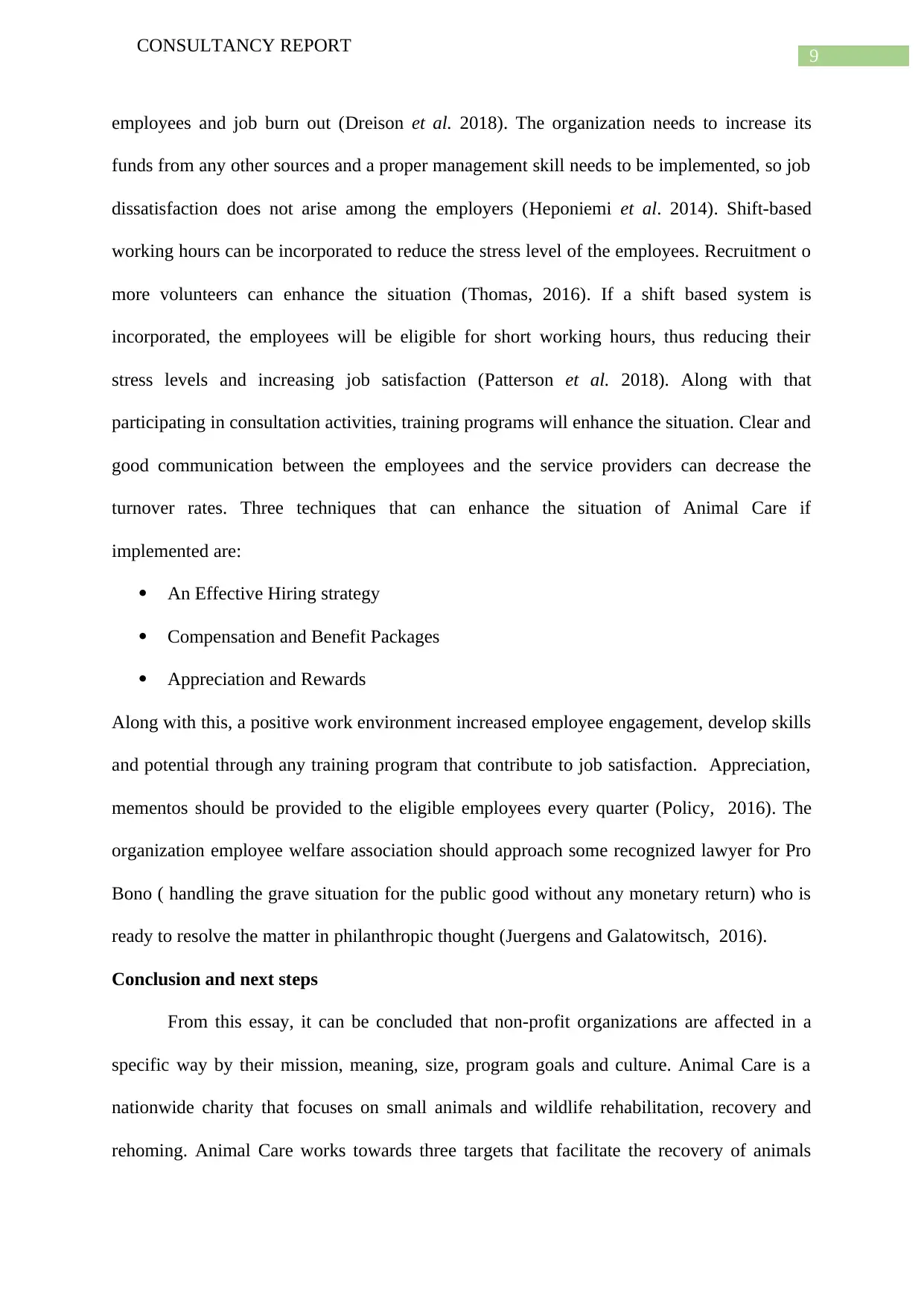
9
CONSULTANCY REPORT
employees and job burn out (Dreison et al. 2018). The organization needs to increase its
funds from any other sources and a proper management skill needs to be implemented, so job
dissatisfaction does not arise among the employers (Heponiemi et al. 2014). Shift-based
working hours can be incorporated to reduce the stress level of the employees. Recruitment o
more volunteers can enhance the situation (Thomas, 2016). If a shift based system is
incorporated, the employees will be eligible for short working hours, thus reducing their
stress levels and increasing job satisfaction (Patterson et al. 2018). Along with that
participating in consultation activities, training programs will enhance the situation. Clear and
good communication between the employees and the service providers can decrease the
turnover rates. Three techniques that can enhance the situation of Animal Care if
implemented are:
An Effective Hiring strategy
Compensation and Benefit Packages
Appreciation and Rewards
Along with this, a positive work environment increased employee engagement, develop skills
and potential through any training program that contribute to job satisfaction. Appreciation,
mementos should be provided to the eligible employees every quarter (Policy, 2016). The
organization employee welfare association should approach some recognized lawyer for Pro
Bono ( handling the grave situation for the public good without any monetary return) who is
ready to resolve the matter in philanthropic thought (Juergens and Galatowitsch, 2016).
Conclusion and next steps
From this essay, it can be concluded that non-profit organizations are affected in a
specific way by their mission, meaning, size, program goals and culture. Animal Care is a
nationwide charity that focuses on small animals and wildlife rehabilitation, recovery and
rehoming. Animal Care works towards three targets that facilitate the recovery of animals
CONSULTANCY REPORT
employees and job burn out (Dreison et al. 2018). The organization needs to increase its
funds from any other sources and a proper management skill needs to be implemented, so job
dissatisfaction does not arise among the employers (Heponiemi et al. 2014). Shift-based
working hours can be incorporated to reduce the stress level of the employees. Recruitment o
more volunteers can enhance the situation (Thomas, 2016). If a shift based system is
incorporated, the employees will be eligible for short working hours, thus reducing their
stress levels and increasing job satisfaction (Patterson et al. 2018). Along with that
participating in consultation activities, training programs will enhance the situation. Clear and
good communication between the employees and the service providers can decrease the
turnover rates. Three techniques that can enhance the situation of Animal Care if
implemented are:
An Effective Hiring strategy
Compensation and Benefit Packages
Appreciation and Rewards
Along with this, a positive work environment increased employee engagement, develop skills
and potential through any training program that contribute to job satisfaction. Appreciation,
mementos should be provided to the eligible employees every quarter (Policy, 2016). The
organization employee welfare association should approach some recognized lawyer for Pro
Bono ( handling the grave situation for the public good without any monetary return) who is
ready to resolve the matter in philanthropic thought (Juergens and Galatowitsch, 2016).
Conclusion and next steps
From this essay, it can be concluded that non-profit organizations are affected in a
specific way by their mission, meaning, size, program goals and culture. Animal Care is a
nationwide charity that focuses on small animals and wildlife rehabilitation, recovery and
rehoming. Animal Care works towards three targets that facilitate the recovery of animals
Paraphrase This Document
Need a fresh take? Get an instant paraphrase of this document with our AI Paraphraser
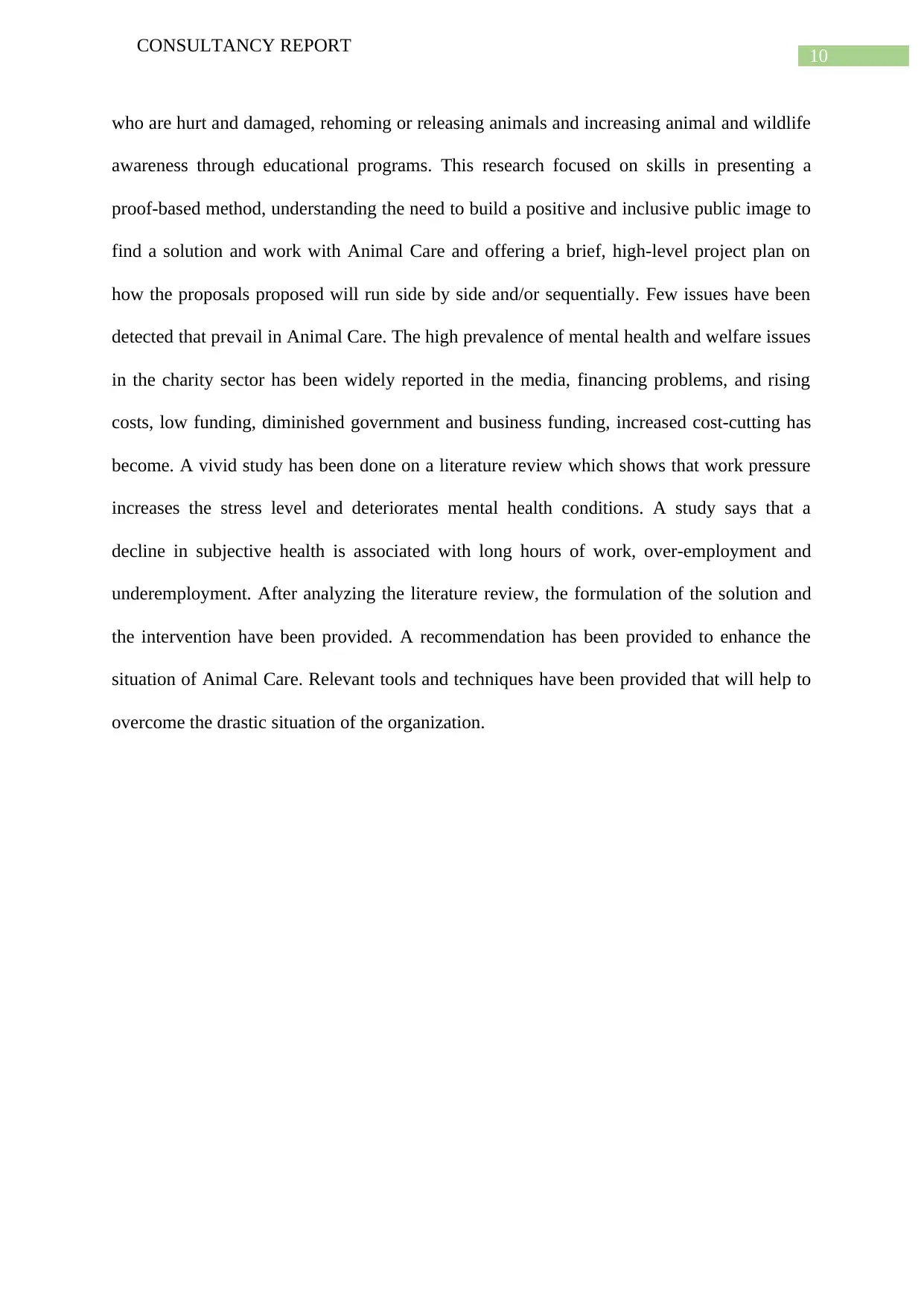
10
CONSULTANCY REPORT
who are hurt and damaged, rehoming or releasing animals and increasing animal and wildlife
awareness through educational programs. This research focused on skills in presenting a
proof-based method, understanding the need to build a positive and inclusive public image to
find a solution and work with Animal Care and offering a brief, high-level project plan on
how the proposals proposed will run side by side and/or sequentially. Few issues have been
detected that prevail in Animal Care. The high prevalence of mental health and welfare issues
in the charity sector has been widely reported in the media, financing problems, and rising
costs, low funding, diminished government and business funding, increased cost-cutting has
become. A vivid study has been done on a literature review which shows that work pressure
increases the stress level and deteriorates mental health conditions. A study says that a
decline in subjective health is associated with long hours of work, over-employment and
underemployment. After analyzing the literature review, the formulation of the solution and
the intervention have been provided. A recommendation has been provided to enhance the
situation of Animal Care. Relevant tools and techniques have been provided that will help to
overcome the drastic situation of the organization.
CONSULTANCY REPORT
who are hurt and damaged, rehoming or releasing animals and increasing animal and wildlife
awareness through educational programs. This research focused on skills in presenting a
proof-based method, understanding the need to build a positive and inclusive public image to
find a solution and work with Animal Care and offering a brief, high-level project plan on
how the proposals proposed will run side by side and/or sequentially. Few issues have been
detected that prevail in Animal Care. The high prevalence of mental health and welfare issues
in the charity sector has been widely reported in the media, financing problems, and rising
costs, low funding, diminished government and business funding, increased cost-cutting has
become. A vivid study has been done on a literature review which shows that work pressure
increases the stress level and deteriorates mental health conditions. A study says that a
decline in subjective health is associated with long hours of work, over-employment and
underemployment. After analyzing the literature review, the formulation of the solution and
the intervention have been provided. A recommendation has been provided to enhance the
situation of Animal Care. Relevant tools and techniques have been provided that will help to
overcome the drastic situation of the organization.
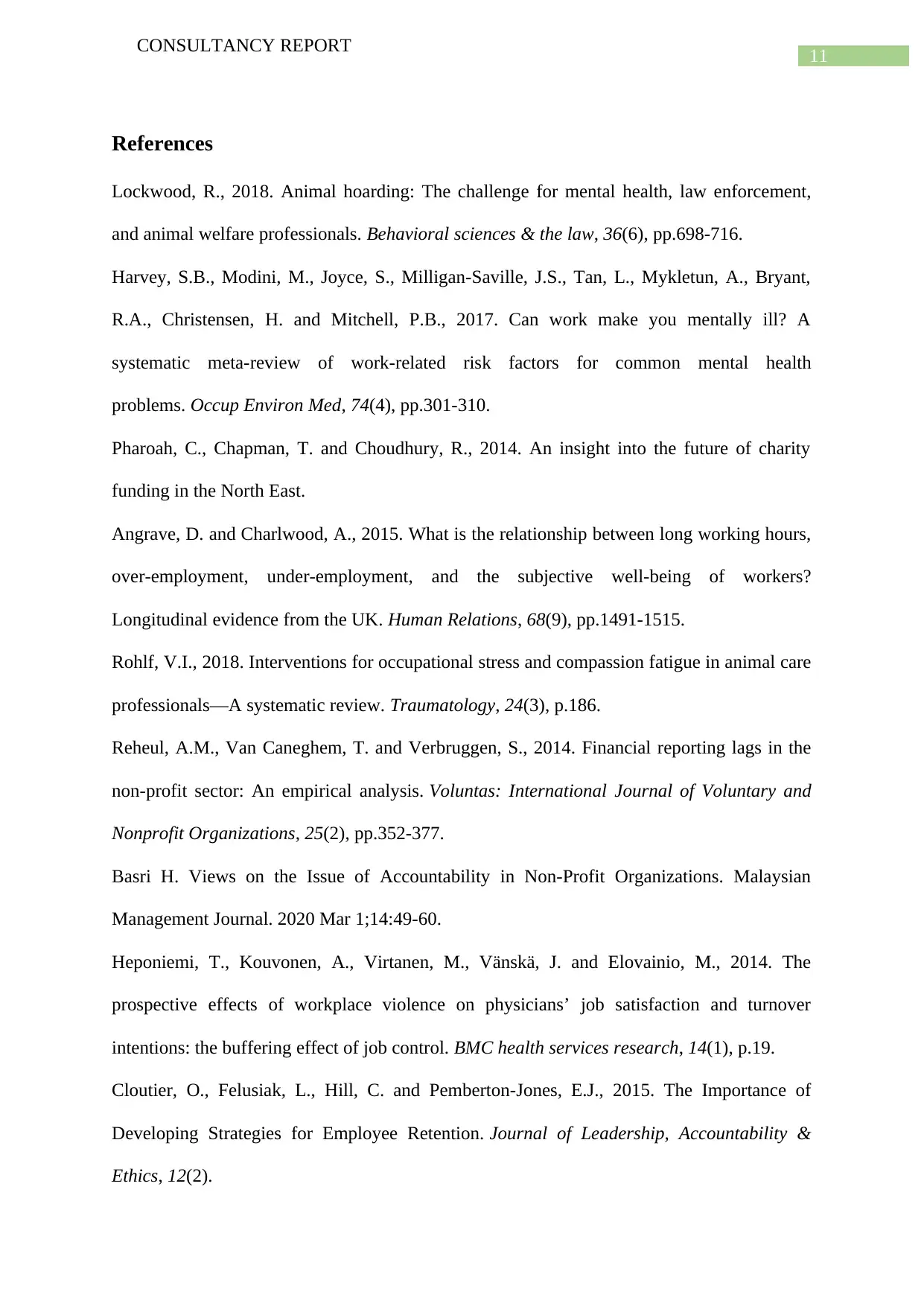
11
CONSULTANCY REPORT
References
Lockwood, R., 2018. Animal hoarding: The challenge for mental health, law enforcement,
and animal welfare professionals. Behavioral sciences & the law, 36(6), pp.698-716.
Harvey, S.B., Modini, M., Joyce, S., Milligan-Saville, J.S., Tan, L., Mykletun, A., Bryant,
R.A., Christensen, H. and Mitchell, P.B., 2017. Can work make you mentally ill? A
systematic meta-review of work-related risk factors for common mental health
problems. Occup Environ Med, 74(4), pp.301-310.
Pharoah, C., Chapman, T. and Choudhury, R., 2014. An insight into the future of charity
funding in the North East.
Angrave, D. and Charlwood, A., 2015. What is the relationship between long working hours,
over-employment, under-employment, and the subjective well-being of workers?
Longitudinal evidence from the UK. Human Relations, 68(9), pp.1491-1515.
Rohlf, V.I., 2018. Interventions for occupational stress and compassion fatigue in animal care
professionals—A systematic review. Traumatology, 24(3), p.186.
Reheul, A.M., Van Caneghem, T. and Verbruggen, S., 2014. Financial reporting lags in the
non-profit sector: An empirical analysis. Voluntas: International Journal of Voluntary and
Nonprofit Organizations, 25(2), pp.352-377.
Basri H. Views on the Issue of Accountability in Non-Profit Organizations. Malaysian
Management Journal. 2020 Mar 1;14:49-60.
Heponiemi, T., Kouvonen, A., Virtanen, M., Vänskä, J. and Elovainio, M., 2014. The
prospective effects of workplace violence on physicians’ job satisfaction and turnover
intentions: the buffering effect of job control. BMC health services research, 14(1), p.19.
Cloutier, O., Felusiak, L., Hill, C. and Pemberton-Jones, E.J., 2015. The Importance of
Developing Strategies for Employee Retention. Journal of Leadership, Accountability &
Ethics, 12(2).
CONSULTANCY REPORT
References
Lockwood, R., 2018. Animal hoarding: The challenge for mental health, law enforcement,
and animal welfare professionals. Behavioral sciences & the law, 36(6), pp.698-716.
Harvey, S.B., Modini, M., Joyce, S., Milligan-Saville, J.S., Tan, L., Mykletun, A., Bryant,
R.A., Christensen, H. and Mitchell, P.B., 2017. Can work make you mentally ill? A
systematic meta-review of work-related risk factors for common mental health
problems. Occup Environ Med, 74(4), pp.301-310.
Pharoah, C., Chapman, T. and Choudhury, R., 2014. An insight into the future of charity
funding in the North East.
Angrave, D. and Charlwood, A., 2015. What is the relationship between long working hours,
over-employment, under-employment, and the subjective well-being of workers?
Longitudinal evidence from the UK. Human Relations, 68(9), pp.1491-1515.
Rohlf, V.I., 2018. Interventions for occupational stress and compassion fatigue in animal care
professionals—A systematic review. Traumatology, 24(3), p.186.
Reheul, A.M., Van Caneghem, T. and Verbruggen, S., 2014. Financial reporting lags in the
non-profit sector: An empirical analysis. Voluntas: International Journal of Voluntary and
Nonprofit Organizations, 25(2), pp.352-377.
Basri H. Views on the Issue of Accountability in Non-Profit Organizations. Malaysian
Management Journal. 2020 Mar 1;14:49-60.
Heponiemi, T., Kouvonen, A., Virtanen, M., Vänskä, J. and Elovainio, M., 2014. The
prospective effects of workplace violence on physicians’ job satisfaction and turnover
intentions: the buffering effect of job control. BMC health services research, 14(1), p.19.
Cloutier, O., Felusiak, L., Hill, C. and Pemberton-Jones, E.J., 2015. The Importance of
Developing Strategies for Employee Retention. Journal of Leadership, Accountability &
Ethics, 12(2).
⊘ This is a preview!⊘
Do you want full access?
Subscribe today to unlock all pages.

Trusted by 1+ million students worldwide
1 out of 14
Your All-in-One AI-Powered Toolkit for Academic Success.
+13062052269
info@desklib.com
Available 24*7 on WhatsApp / Email
![[object Object]](/_next/static/media/star-bottom.7253800d.svg)
Unlock your academic potential
Copyright © 2020–2025 A2Z Services. All Rights Reserved. Developed and managed by ZUCOL.